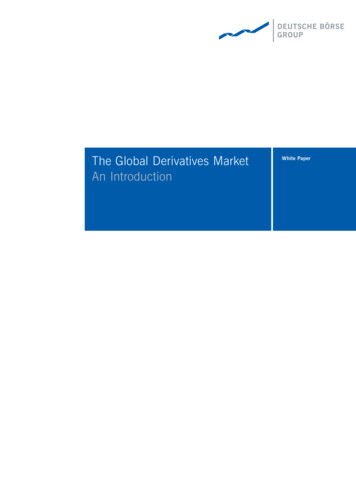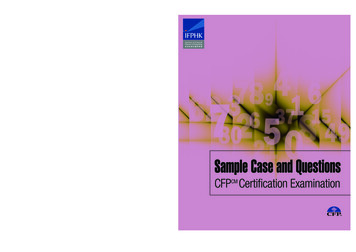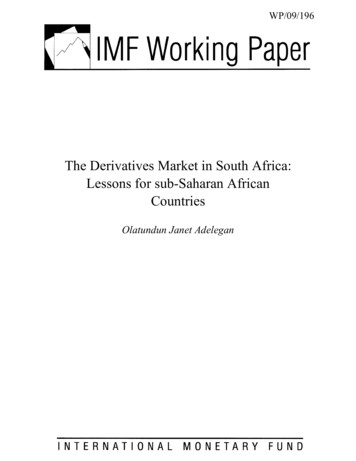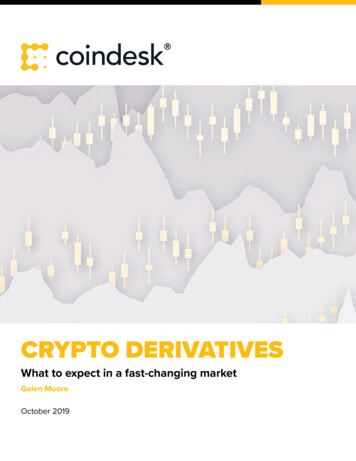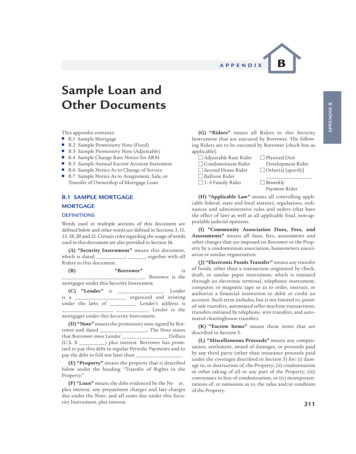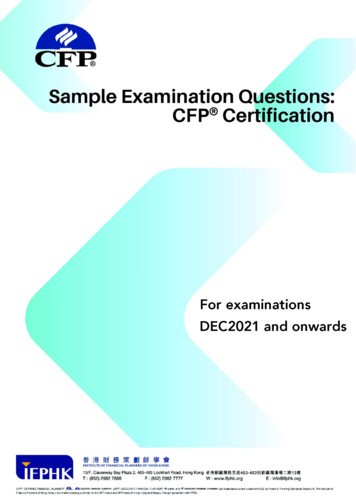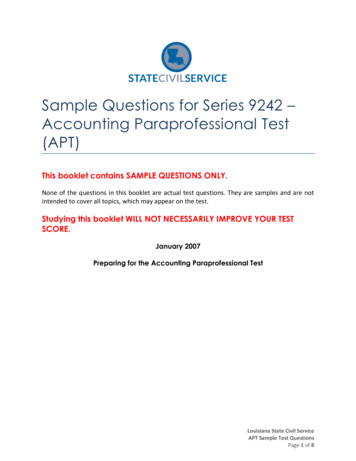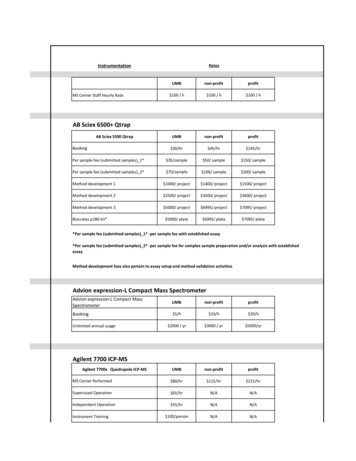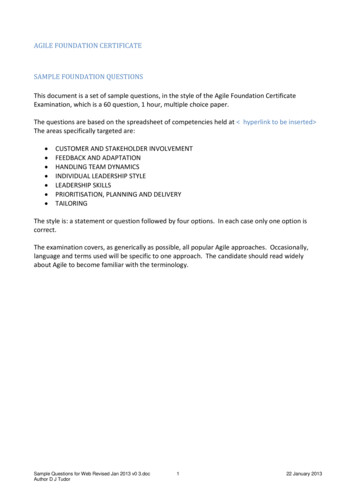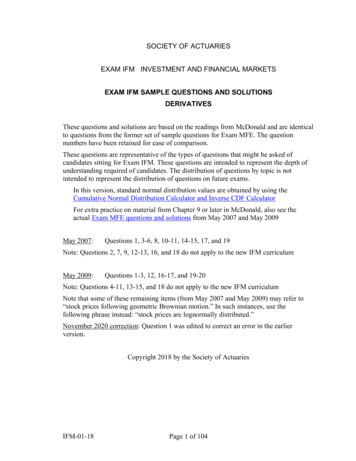
Transcription
SOCIETY OF ACTUARIESEXAM IFM INVESTMENT AND FINANCIAL MARKETSEXAM IFM SAMPLE QUESTIONS AND SOLUTIONSDERIVATIVESThese questions and solutions are based on the readings from McDonald and are identicalto questions from the former set of sample questions for Exam MFE. The questionnumbers have been retained for ease of comparison.These questions are representative of the types of questions that might be asked ofcandidates sitting for Exam IFM. These questions are intended to represent the depth ofunderstanding required of candidates. The distribution of questions by topic is notintended to represent the distribution of questions on future exams.In this version, standard normal distribution values are obtained by using theCumulative Normal Distribution Calculator and Inverse CDF CalculatorFor extra practice on material from Chapter 9 or later in McDonald, also see theactual Exam MFE questions and solutions from May 2007 and May 2009May 2007:Questions 1, 3-6, 8, 10-11, 14-15, 17, and 19Note: Questions 2, 7, 9, 12-13, 16, and 18 do not apply to the new IFM curriculumMay 2009:Questions 1-3, 12, 16-17, and 19-20Note: Questions 4-11, 13-15, and 18 do not apply to the new IFM curriculumNote that some of these remaining items (from May 2007 and May 2009) may refer to“stock prices following geometric Brownian motion.” In such instances, use thefollowing phrase instead: “stock prices are lognormally distributed.”Copyright 2018 by the Society of ActuariesIFM-01-18Page 1 of 105
Introductory Derivatives Questions1.Determine which statement about zero-cost purchased collars is FALSE(A)A zero-width, zero-cost collar can be created by setting both the put andcall strike prices at the forward price.(B)There are an infinite number of zero-cost collars.(C)The put option can be at-the-money.(D)The call option can be at-the-money.(E)The strike price on the put option must be at or below the forward price.2.You are given the following: The current price to buy one share of XYZ stock is 500. The stock does not pay dividends. The continuously compounded risk-free interest rate is 6%. A European call option on one share of XYZ stock with a strike price of K thatexpires in one year costs 66.59. A European put option on one share of XYZ stock with a strike price of K thatexpires in one year costs 18.64.Using put-call parity, calculate the strike price, K.(A)449(B)452(C)480(D)559(E)582IFM-01-18Page 2 of 105
3.Happy Jalapenos, LLC has an exclusive contract to supply jalapeno peppers to theorganizers of the annual jalapeno eating contest. The contract states that the contestorganizers will take delivery of 10,000 jalapenos in one year at the market price. It willcost Happy Jalapenos 1,000 to provide 10,000 jalapenos and today’s market price is 0.12for one jalapeno. The continuously compounded risk-free interest rate is 6%.Happy Jalapenos has decided to hedge as follows:Buy 10,000 0.12-strike put options for 84.30 and sell 10,000 0.14-stike call options for74.80. Both options are one-year European.Happy Jalapenos believes the market price in one year will be somewhere between 0.10and 0.15 per jalapeno.Determine which of the following intervals represents the range of possible profit oneyear from now for Happy Jalapenos.(A)–200 to 100(B)–110 to 190(C)–100 to 200(D)190 to 390(E)200 to 4004.DELETEDIFM-01-18Page 3 of 105
5.The PS index has the following characteristics: One share of the PS index currently sells for 1,000. The PS index does not pay dividends.Sam wants to lock in the ability to buy this index in one year for a price of 1,025. He cando this by buying or selling European put and call options with a strike price of 1,025.The annual effective risk-free interest rate is 5%.Determine which of the following gives the hedging strategy that will achieve Sam’sobjective and also gives the cost today of establishing this position.(A)Buy the put and sell the call, receive 23.81(B)Buy the put and sell the call, spend 23.81(C)Buy the put and sell the call, no cost(D)Buy the call and sell the put, receive 23.81(E)Buy the call and sell the put, spend 23.816.The following relates to one share of XYZ stock: The current price is 100. The forward price for delivery in one year is 105. P is the expected price in one yearDetermine which of the following statements about P is TRUE.(A)P 100(B)P 100(C)100 P 105(D)P 105(E)P 105IFM-01-18Page 4 of 105
7.A non-dividend paying stock currently sells for 100. One year from now the stock sellsfor 110. The continuously compounded risk-free interest rate is 6%. A trader purchasesthe stock in the following manner: The trader pays 100 today The trader takes possession of the stock in one yearDetermine which of the following describes this arrangement.(A)Outright purchase(B)Fully leveraged purchase(C)Prepaid forward contract(D)Forward contract(E)This arrangement is not possible due to arbitrage opportunities8.Joe believes that the volatility of a stock is higher than indicated by market prices foroptions on that stock. He wants to speculate on that belief by buying or selling at-themoney options.Determine which of the following strategies would achieve Joe’s goal.(A)Buy a strangle(B)Buy a straddle(C)Sell a straddle(D)Buy a butterfly spread(E)Sell a butterfly spreadIFM-01-18Page 5 of 105
9.Stock ABC has the following characteristics: The current price to buy one share is 100. The stock does not pay dividends. European options on one share expiring in one year have the following prices:Strike PriceCall option pricePut option price9014.630.241006.801.931102.176.81A butterfly spread on this stock has the following profit diagram.8642085809095100105110115120-2-4The continuously compounded risk-free interest rate is 5%.Determine which of the following will NOT produce this profit diagram.(A)Buy a 90 put, buy a 110 put, sell two 100 puts(B)Buy a 90 call, buy a 110 call, sell two 100 calls(C)Buy a 90 put, sell a 100 put, sell a 100 call, buy a 110 call(D)Buy one share of the stock, buy a 90 call, buy a 110 put, sell two 100 puts(E)Buy one share of the stock, buy a 90 put, buy a 110 call, sell two 100 calls.IFM-01-18Page 6 of 105
10.Stock XYZ has a current price of 100. The forward price for delivery of this stock in 1year is 110.Unless otherwise indicated, the stock pays no dividends and the annual effective risk-freeinterest rate is 10%.Determine which of the following statements is FALSE.(A)The time-1 profit diagram and the time-1 payoff diagram for longpositions in thisforward contract are identical.(B)The time-1 profit for a long position in this forward contract is exactlyopposite to the time-1 profit for the corresponding short forward position.(C)There is no comparative advantage to investing in the stock versusinvesting in the forward contract.(D)If the 10% interest rate was continuously compounded instead of annualeffective, then it would be more beneficial to invest in the stock, ratherthan the forward contract.(E)If there was a dividend of 3.00 paid 6 months from now, then it would bemore beneficial to invest in the stock, rather than the forward contract.IFM-01-18Page 7 of 105
11.Stock XYZ has the following characteristics: The current price is 40. The price of a 35-strike 1-year European call option is 9.12. The price of a 40-strike 1-year European call option is 6.22. The price of a 45-strike 1-year European call option is 4.08.The annual effective risk-free interest rate is 8%.Let S be the price of the stock one year from now.All call positions being compared are long.Determine the range for S such that the 45-strike call produce a higher profit than the 40strike call, but a lower profit than the 35-strike call.(A)S 38.13(B)38.13 S 40.44(C)40.44 S 42.31(D)S 42.31(E)The range is empty.12.Consider a European put option on a stock index without dividends, with 6 months toexpiration and a strike price of 1,000. Suppose that the effective six-month interest rateis 2%, and that the put costs 74.20 today.Calculate the price that the index must be in 6 months so that being long in the put wouldproduce the same profit as being short in the 77.17IFM-01-18Page 8 of 105
13.A trader shorts one share of a stock index for 50 and buys a 60-strike European calloption on that stock that expires in 2 years for 10. Assume the annual effective risk-freeinterest rate is 3%.The stock index increases to 75 after 2 years.Calculate the profit on your combined position, and determine an alternative name forthis combined ” Covered Call14.The current price of a non-dividend paying stock is 40 and the continuously compoundedrisk-free interest rate is 8%. You are given that the price of a 35-strike call option is 3.35higher than the price of a 40-strike call option, where both options expire in 3 months.Calculate the amount by which the price of an otherwise equivalent 40-strike put optionexceeds the price of an otherwise equivalent 35-strike put 8Page 9 of 105
15.The current price of a non-dividend paying stock is 40 and the continuously compoundedrisk-free interest rate is 8%. You enter into a short position on 3 call options, each with 3months to maturity, a strike price of 35, and an option premium of 6.13. Simultaneously,you enter into a long position on 5 call options, each with 3 months to maturity, a strikeprice of 40, and an option premium of 2.78.All 8 options are held until maturity.Calculate the maximum possible profit and the maximum possible loss for the entireoption portfolio.Maximum ProfitMaximum 8Unlimited(E)UnlimitedUnlimitedIFM-01-18Page 10 of 105
16.The current price of a non-dividend paying stock is 40 and the continuously compoundedrisk-free interest rate is 8%. The following table shows call and put option premiums forthree-month European of various exercise prices:Exercise PriceCall PremiumPut Premium356.130.44402.781.99450.975.08A trader interested in speculating on volatility in the stock price is considering twoinvestment strategies. The first is a 40-strike straddle. The second is a strangleconsisting of a 35-strike put and a 45-strike call.Determine the range of stock prices in 3 months for which the strangle outperforms thestraddle.(A)The strangle never outperforms the straddle.(B)33.56 ST 46.44(C)35.13 ST 44.87(D)36.57 ST 43.43(E)The strangle always outperforms the straddle.IFM-01-18Page 11 of 105
17.The current price for a stock index is 1,000. The following premiums exist for variousoptions to buy or sell the stock index six months from now:Strike PriceCall PremiumPut 21Strategy I is to buy the 1,050-strike call and to sell the 950-strike call.Strategy II is to buy the 1,050-strike put and to sell the 950-strike put.Strategy III is to buy the 950-strike call, sell the 1,000-strike call, sell the 950-strike put,and buy the 1,000-strike put.Assume that the price of the stock index in 6 months will be between 950 and 1,050.Determine which, if any, of the three strategies will have greater payoffs in six monthsfor lower prices of the stock index than for relatively higher prices.(A)None(B)I and II only(C)I and III only(D)II and III only(E)The correct answer is not given by (A), (B), (C), or (D)IFM-01-18Page 12 of 105
18.DELETED19.DELETED20.The current price of a stock is 200, and the continuously compounded risk-free interestrate is 4%. A dividend will be paid every quarter for the next 3 years, with the firstdividend occurring 3 months from now. The amount of the first dividend is 1.50, buteach subsequent dividend will be 1% higher than the one previously paid.Calculate the fair price of a 3-year forward contract on this stock.(A)200(B)205(C)210(D)215(E)22021.A market maker in stock index forward contracts observes a 6-month forward price of112 on the index. The index spot price is 110 and the continuously compoundeddividend yield on the index is 2%.The continuously compounded risk-free interest rate is 5%.Describe actions the market maker could take to exploit an arbitrage opportunity andcalculate the resulting profit (per index unit).(A)Buy observed forward, sell synthetic forward, Profit 0.34(B)Buy observed forward, sell synthetic forward, Profit 0.78(C)Buy observed forward, sell synthetic forward, Profit 1.35(D)Sell observed forward, buy synthetic forward, Profit 0.78(E)Sell observed forward, buy synthetic forward, Profit 0.34IFM-01-18Page 13 of 105
22.DELETED23.DELETED24.Determine which of the following statements is NOT a typical reason for why derivativesecurities are used to manage financial risk.(A)Derivatives are used as a means of hedging.(B)Derivatives are used to reduce the likelihood of bankruptcy.(C)Derivatives are used to reduce transaction costs.(D)Derivatives are used to satisfy regulatory, tax, and accounting constraints.(E)Derivatives are used as a form of insurance.25.DELETED26.Determine which, if any, of the following positions has or have an unlimited losspotential from adverse price movement in the underlying asset, regardless of the initialpremium received.I.Short 1 forward contractII.Short 1 call optionIII.Short 1 put option(A)None(B)I and II only(C)I and III only(D)II and III only(E)The correct answer is not given by (A), (B), (C), or (D)IFM-01-18Page 14 of 105
27.DELETED28.DELETED29.The dividend yield on a stock and the interest rate used to discount the stock’s cash flowsare both continuously compounded. The dividend yield is less than the interest rate, butboth are positive.The following table shows four methods to buy the stock and the total payment neededfor each method. The payment amounts are as of the time of payment and have not beendiscounted to the present date.METHODTOTAL PAYMENTOutright purchaseAFully leveraged purchaseBPrepaid forward contractCForward contractDDetermine which of the following is the correct ranking, from smallest to largest, for theamount of payment needed to acquire the stock.(A)C A D B(B)A C D B(C)D C A B(D)C A B D(E)A C B DIFM-01-18Page 15 of 105
30.Determine which of the following is NOT a distinguishing characteristic of futurescontracts, relative to forward contracts.(A)Contracts are settled daily, and marked-to-market.(B)Contracts are more liquid, as one can offset an obligation by taking theopposite position.(C)Contracts are more customized to suit the buyer’s needs.(D)Contracts are structured to minimize the effects of credit risk.(E)Contracts have price limits, beyond which trading may be temporarilyhalted.31.DELETED32.Judy decides to take a short position in 20 contracts of S&P 500 futures. Each contract isfor the delivery of 250 units of the index at a price of 1500 per unit, exactly one monthfrom now. The initial margin is 5% of the notional value, and the maintenance margin is90% of the initial margin. Judy earns a continuously compounded risk-free interest rateof 4% on her margin balance. The position is marked-to-market on a daily basis.On the day of the first marking-to-market, the value of the index drops to 1498. On theday of the second marking-to-market, the value of the index is X and Judy is not requiredto add anything to the margin account.Calculate the largest possible value of 50IFM-01-18Page 16 of 105
33.Several years ago, John bought three separate 6-month options on the same stock. Option I was an American-style put with strike price 20. Option II was a Bermuda-style call with strike price 25, where exercise wasallowed at any time following an initial 3-month period of call protection. Option III was a European-style put with strike price 30.When the options were bought, the stock price was 20.When the options expired, the stock price was 26.The table below gives the maximum and minimum stock price during the 6 month period:1st 3 months of Option Term2nd 3 months of Option TermMaximum Stock Price2428Minimum Stock Price1822Time Period:John exercised each option at the optimal time.Rank the three options, from highest to lowest payoff.(A)I II III(B)I III II(C)II I III(D)III I II(E)III II I34.DELETEDIFM-01-18Page 17 of 105
35.A customer buys a 50-strike put on an index when the market price of the index is also50.The premium for the put is 5. Assume that the option contract is for an underlying 100units of the index.Calculate the customer’s profit if the index declines to 45 at DELETED37.A one-year forward contract on a stock has a price of 75. The stock is expected to pay adividend of 1.50 at two future times, six months from now and one year from now, andthe annual effective risk-free interest rate is 6%.Calculate the current stock 01-18Page 18 of 105
38.The current price of a medical company’s stock is 75. The expected value of the stockprice in three years is 90 per share. The stock pays no dividends.You are also giveni)The risk-free interest rate is positive.ii)There are no transaction costs.iii)Investors require compensation for risk.The price of a three-year forward on a share of this stock is X, and at this price aninvestor is willing to enter into the forward.Determine what can be concluded about X.(A)X 75(B)X 75(C)75 X 90(D)X 90(E)90 X39.Determine which of the following strategies creates a ratio spread, assuming all optionsare European.(A)Buy a one-year call, and sell a three-year call with the same strike price.(B)Buy a one-year call, and sell a three-year call with a different strike price.(C)Buy a one-year call, and buy three one-year calls with a different strike price.(D)Buy a one-year call, and sell three one-year puts with a different strike price.(E)Buy a one-year call, and sell three one-year calls with a different strike price.IFM-01-18Page 19 of 105
40.An investor is analyzing the costs of two-year, European options for aluminum and zincat a particular strike price.For each ton of aluminum, the two-year forward price is 1400, a call option costs 700,and a put option costs 550.For each ton of zinc, the two-year forward price is 1600 and a put option costs 550.The annual effective risk-free interest rate is 6%.Calculate the cost of a call option per ton of zinc.(A)522(B)800(C)878(D)900(E)123141.XYZ stock pays no dividends and its current price is 100.Assume the put, the call and the forward on XYZ stock are available and are priced sothere are no arbitrage opportunities. Also, assume there are no transaction costs.The annual effective risk-free interest rate is 1%.Determine which of the following strategies currently has the highest net premium.(A)Long a six-month 100-strike put and short a six-month 100-strike call(B)Long a six-month forward on the stock(C)Long a six-month 101-strike put and short a six-month 101-strike call(D)Short a six-month forward on the stock(E)Long a six-month 105-strike put and short a six-month 105-strike callIFM-01-18Page 20 of 105
42.An investor purchases a non-dividend-paying stock and writes a t-year, European calloption for this stock, with call premium C. The stock price at time of purchase and strikeprice are both K.Assume that there are no transaction costs.The risk-free annual force of interest is a constant r. Let S represent the stock price attime t.S K.Determine an algebraic expression for the investor’s profit at expiration.(A)Cert(B)C (1 rt ) S K(C)Cert S K(D)Cert K (1 e rt )(E)C (1 r )t K 1 (1 r )t IFM-01-18Page 21 of 105
43.You are given:i)An investor short-sells a non-dividend paying stock that has a currentprice of 44 per share.ii)This investor also writes a collar on this stock consisting of a 40-strikeEuropean put option and a 50-strike European call option. Both optionsexpire in one year.iii)The prices of the options on this stock are:Strike PriceCall optionPut option408.422.47503.867.42iv)The continuously compounded risk-free interest rate is 5%.v)Assume there are no transaction costs.Calculate the maximum profit for the overall position at 01-18Page 22 of 105
44.You are given the following information about two options, A and B:i)Option A is a one-year European put with exercise price 45.ii)Option B is a one-year American call with exercise price 55.iii)Both options are based on the same underlying asset, a stock that pays nodividends.iv)Both options go into effect at the same time and expire at t 1.You are also given the following information about the stock price:i)The initial stock price is 50.ii)The stock price at expiration is also 50.iii)The minimum stock price (from t 0 to t 1) is 46.iv)The maximum stock price (from t 0 to t 1) is 58.Determine which of the following statements is true.(A)Both options A and B are “at-the-money” at expiration.(B)Both options A and B are “in-the-money” at expiration.(C)Both options A and B are “out-of-the-money” throughout each option’sterm.(D)Only option A is ever “in-the-money” at some time during its term.(E)Only option B is ever “in-the-money” at some time during its term.IFM-01-18Page 23 of 105
45.An investor enters a long position in a futures contract on an index (F) with a notionalvalue of 200 F, expiring in one year. The index pays a continuously compoundeddividend yield of 4%, and the continuously compounded risk-free interest rate is 2%.At the time of purchase, the index price is 1100. Three months later, the investor hassustained a loss of 100. Assume the margin account earns an interest rate of 0%.Let S be the price of the index at the end of month three.Calculate S.(A)1078(B)1085(C)1094(D)1105(E)111046.Determine which of the following statements about options is true.(A)Naked writing is the practice of buying options without taking anoffsetting position in the underlying asset.(B)A covered call involves taking a long position in an asset together with awritten call on the same asset.(C)An American style option can only be exercised during specified periods,but not for the entire life of the option.(D)A Bermudan style option allows the buyer the right to exercise at any timeduring the life of the option.(E)An in-the-money option is one which would have a positive profit ifexercised immediately.IFM-01-18Page 24 of 105
47.An investor has written a covered call.Determine which of the following represents the investor's position.(A)Short the call and short the stock(B)Short the call and long the stock(C)Short the call and no position on the stock(D)Long the call and short the stock(E)Long the call and long the stock48.For a certain stock, Investor A purchases a 45-strike call option while Investor Bpurchases a 135-strike put option. Both options are European with the same expirationdate. Assume that there are no transaction costs.If the final stock price at expiration is S, Investor A's payoff will be 12.Calculate Investor B's payoff at expiration, if the final stock price is S.(A)0(B)12(C)36(D)57(E)78IFM-01-18Page 25 of 105
49.The market price of Stock A is 50. A customer buys a 50-strike put contract on Stock Afor 500. The put contract is for 100 shares of A.Calculate the customer’s maximum possible loss.(A)0(B)5(C)50(D)500(E)500050.An investor bought a 70-strike European put option on an index with six months toexpiration. The premium for this option was 1.The investor also wrote an 80-strike European put option on the same index with sixmonths to expiration. The premium for this option was 8.The six-month interest rate is 0%.Calculate the index price at expiration that will allow the investor to break even.(A)63(B)73(C)77(D)80(E)87IFM-01-18Page 26 of 105
51.You are given the following information about Stock XYZ:i)The current price of the stock is 35 per share.ii)The expected continuously compounded rate of return is 8%.iii)The stock pays semi-annual dividends of 0.32 per share, with the nextdividend to be paid two months from now.The continuously compounded risk-free interest rate is 4%.Calculate the current one-year forward price for stock XYZ.(A)34.37(B)35.77(C)36.43(D)37.23(E)37.9252.The ask price for a share of ABC company is 100.50 and the bid price is 100. Supposean investor can borrow at an annual effective rate of 3.05% and lend (i.e., save) at anannual effective rate of 3%. Assume there are no transaction costs and no dividends.Determine which of the following strategies does not create an arbitrage opportunity.(A)Short sell one share, and enter into a long one-year forward contract onone share with a forward price of 102.50.(B)Short sell one share, and enter into a long one-year forward contract onone share with a forward price of 102.75.(C)Short sell one share, and enter into a long one-year forward contract onone share with a forward price of 103.00.(D)Purchase one share with borrowed money, and enter into a short one-yearforward contract on one share with a forward price of 103.60.(E)Purchase one share with borrowed money, and enter into a short one-yearforward contract on one share with a forward price of 103.75.IFM-01-18Page 27 of 105
53.For each ton of a certain type of rice commodity, the four-year forward price is 300. Afour-year 400-strike European call option costs 110.The continuously compounded risk-free interest rate is 6.5%.Calculate the cost of a four-year 400-strike European put option for this rice .0054.DELETED55.Box spreads are used to guarantee a fixed cash flow in the future. Thus, they are purely ameans of borrowing or lending money, and have no stock price risk.Consider a box spread based on two distinct strike prices (K, L) that is used to lendmoney, so that there is a positive cost to this transaction up front, but a guaranteedpositive payoff at expiration.Determine which of the following sets of transactions is equivalent to this type of boxspread.(A)A long position in a (K, L) bull spread using calls and a long position in a(K, L) bear spread using puts.(B)A long position in a (K, L) bull spread using calls and a short position in a(K, L) bear spread using puts.(C)A long position in a (K, L) bull spread using calls and a long position in a(K, L) bull spread using puts.(D)A short position in a (K, L) bull spread using calls and a short position in a(K, L) bear spread using puts.(E)A short position in a (K, L) bull spread using calls and a short position ina(K, L) bull spread using puts.IFM-01-18Page 28 of 105
56.Determine which of the following positions has the same cash flows as a short stockposition.(A)Long forward and long zero-coupon bond(B)Long forward and short forward(C)Long forward and short zero-coupon bond(D)Long zero-coupon bond and short forward(E)Short forward and short zero-coupon bond57.DELETED58.DELETEDIFM-01-18Page 29 of 105
59.An investor has a long position in a non-dividend-paying stock, and additionally, has along collar on this stock consisting of a 40-strike put and 50-strike call.Determine which of these graphs represents the payoff diagram for the overall position atthe time of expiration of the options.(B)PayoffPayoff(A)203040Stock Price5060703040203040Stock Price506070(D)PayoffPayoff(C)20203040Stock Price506070(E)IFM-01-18Page 30 of 105Stock Price506070
Payoff203040Stock Price50607060.Farmer Brown grows wheat, and will be selling his crop in 6 months. The current priceof wheat is 8.50 per bushel. To reduce the risk of fluctuation in price, Brown wants touse derivatives with a 6-month expiration date to sell wheat between 8.60 and 8.80 perbushel. Brown also wants to minimize the cost of using derivatives.The continuously compounded risk-free interest rate is 2%.Which of the following strategies fulfills Farmer Brown’s objectives?(A)Short a forward contract(B)Long a call with strike 8.70 and short a put with strike 8.70(C)Long a call with strike 8.80 and short a put with strike 8.60(D)Long a put with strike 8.60(E)Long a put with strike 8.60 and short a call with strike 8.8061.An investor purchased Option A and Option B for a certain stock today, with strike prices70 and 80, respectively. Both options are European one-year put options.Determine which statement is true about the moneyness of these options, based on aparticular stock price.(A)If Option A is in-the-money, then Option B is in-the-money.(B)If Option A is at-the-money, then Option B is out-of-the-money.(C)If Option A is in-the-money, then Option B is out-of-the-money.(D)If Option A is out-of-the-money, then Option B is in-the-money.IFM-01-18Page 31 of 105
(E)IFM-01-18If Option A is out-of-the-money, then Option B is out-of-the-money.Page 32 of 105
62.The price of an asset will either rise by 25% or fall by 40% in 1 year, with equalprobability. A European put option on this asset matures after 1 year.Assume the following: Price of the asset today: 100 Strike price of the put option: 130 Put option premium: 7 Annual effective risk free rate: 3%Calculate the expected profit of the put DELETED64.DELETEDIFM-01-18Page 33 of 105
65.Assume that a single stock is the underlying asset for a forward contract, a K-strike calloption, and a K-strike put option.Assume also that all three derivatives are evaluated at the same point in time.Which of the following formulas represents put-call parity?(A)Call Premium – Put Premium Present Value (Forward Price – K)(B)Call Premium – Put Premium Present Value (Forward Price)(C)Put Premium – Call Premium 0(D)Put Premium – Call Premium Present Value (Forward Price – K)(E)Put Premium – Call Premium Present Value (Forward Price)66.The current price of a stock is 80. Both call and put options on this stock are availa
risk-free interest rate is 8%. You are given that the price of a 35-strike call option is 3.35 higher than the price of a 40-strike call option, where both options expire in 3 months. Calculate the amount by which the price of an otherwise equivalent 40-strike put option exceeds the price of an otherwise equivalent 35-strike put option. (A) 1.55
